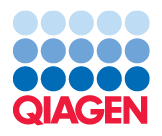Identify QIAseq DNA Somatic Variants with TMB Score
The Identify QIAseq DNA Somatic Variants with TMB Score (Illumina) or (Ion Torrent) template workflows have been designed to support the DHS-8800Z and DHS-6600Z QIAseq Targeted DNA panels. These panels cover a significantly larger region of the genome than classic Targeted DNA panels, which increases the difficulty of variant calling especially with regards to specificity. Through a series of tools and filters, the Identify TMB Status template workflow has the ability to accurately call variants and to compute a TMB score and score confidence that can be classified as low, intermediate or high.
To run the workflows go to:
Template Workflows | Biomedical Workflows (![]() ) | QIAseq Sample Analysis (
) | QIAseq Sample Analysis (![]() ) | QIAseq DNA Workflows (
) | QIAseq DNA Workflows (![]() ) | Identify QIAseq DNA Somatic Variants with TMB Score (Illumina/Ion Torrent) (
) | Identify QIAseq DNA Somatic Variants with TMB Score (Illumina/Ion Torrent) (![]() )
)
Options in the following dialogs can be configured:
- Choose where to run. If you are connected to a CLC Server via the CLC Workbench, you will be asked where you would like to run the analysis. We recommend that you run the analysis on a CLC Server when possible.
- Select Reads. Select the sequencing reads. When analyzing more than one sample at a time, check the Batch checkbox in the lower left corner of the dialog.
- Specify reference data handling. Select the relevant Reference Data Set, see Reference data management for details. QIAseq TMB Panels hg38 will be pre-selected and is recommended for running this workflow.
- Configure batching. If running the workflow in Batch mode, you will be asked to define the batch units. See https://resources.qiagenbioinformatics.com/manuals/clcgenomicsworkbench/current/index.php?manual=Running_workflows_in_batch_mode.html for details.
- Target regions. Choose the relevant target regions from the drop down list.
- Target primers. Choose the relevant target primers from the drop down list.
- Mispriming events. Choose the relevant track for correction of mispriming events from the drop down list.
- Gene-pseudogene track. Choose the relevant track for pseudogene and gene family interference correction from the drop down list.
- Map Reads to Reference. Here, it is possible to configure masking. A custom masking track can be used, but by default, the masking track is set to GenomeReferenceConsortium_masking_hg38_no_alt_analysis_set, containing the regions defined by the Genome Reference Consortium, which serve primarily to remove false duplications, including one affecting the gene U2AF1.
- QC for Target Sequencing. Set the Minimum coverage parameter of the QC for Target Sequencing tool. Using default settings, samples where 90 percent of target region positions do not meet this threshold will be flagged in the sample report generated by the workflow.
- Copy Number Variant Detection (Targeted). Specify Controls against which the coverage pattern in your sample will be compared in order to call CNVs. If you do not specify a control mapping the CNV analysis will not be carried out. Please note that if you want the CNV analysis to be done, it is important that the control mapping supplied is a meaningful control for the sample being analyzed. Mapping of control samples for the CNV analysis can be done using the workflows described in Create QIAseq DNA CNV Control Mapping. A meaningful control must satisfy two conditions: (1) It must have a copy number status that is meaningful to compare against. For panels with targets on the X and Y chromosomes, the control and sample should be matched for gender. (2) The control read mapping must result from the same type of processing that will be applied to the sample. For more information about CNV detection see https://resources.qiagenbioinformatics.com/manuals/clcgenomicsworkbench/current/index.php?manual=Copy_Number_Variant_Detection.html.
- Identify candidate variants. The filtering cascade has been tuned using samples of relatively high quality and coverage to provide the best possible sensitivity and precision. Note that selected default values vary by technology (Illumina / Ion Torrent). Additional filtering may be needed, or filtering values may need to be adjusted, when working with low quality/coverage samples or when seeking a different balance between sensitivity and precision. See https://resources.qiagenbioinformatics.com/manuals/clcgenomicsworkbench/current/index.php?manual=Filter_on_Custom_Criteria.html for details on how to adjust the options.
- Remove False Positives. Set the minimum frequency for detected variants.
- Add information about Amino Acid Changes. Specify the genetic code to be used for amino acid translation.
- Calculate TMB Score. Specify whether the calculation of a TMB status should be performed and if so, set appropriate thresholds. The Calculate TMB Score tool performs an additional series of filtering including removal of known germlines variants and variants that are likely to be germline based on the observed variant allele frequency.
- Create Sample Report. Specify QC items for assessment and subsequent flagging in the sample report generated by the workflow. For additional information, see https://resources.qiagenbioinformatics.com/manuals/clcgenomicsworkbench/current/index.php?manual=Create_Sample_Report.html.
- Result handling. Choose if a workflow result metadata and/or log should be saved.
- Save location for new elements. Choose where to save the data, and press Finish to start the analysis.
Launching using the QIAseq Panel Analysis Assistant
The workflow is also available in the QIAseq Panel Analysis Assistant under Targeted TMB/MSI.
Subsections
